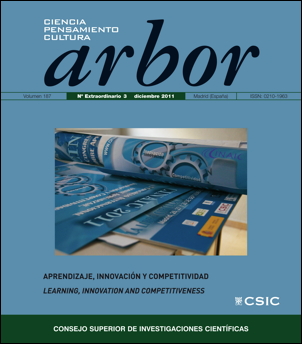Approach to an Emotional Learning Method (ELM) in teaching of Architecture
DOI:
https://doi.org/10.3989/arbor.2011.Extra-3n3154Keywords:
Architecture, EEES, Bolonia, Emotional Education, Emotional Learning Method (ELM)Abstract
The teachings of Architecture in Spain have undergone significant changes in the legislative environment in the last 50 years. The formation of Architecture, based mostly in the workshop format, is an element of coordination between different learning techniques. This paper presents an approach to an Emotional Learning Method (ELM), which aims to integrate in the area of Bologna, a teaching methodology specifically sensitive to the teachings of Architecture. The results obtained in the last two years, since the introduction of the degree at the University of Nebrija have been specially promising and have provided a stimulus for teachers and students. We understand that this learning methodology is transferable to degree programs of both theoretical artistic, or humanistic character.
Downloads
References
Álvarez Álvarez, M. B. (2005): “Adaptación del método docente al Espacio Europeo de Educación Superior: La motivación de los alumnos como instrumento clave”, ESE. Estudios sobre educación, n.º 9, 107-126.
Baker, A.; Jensen, P. J. y Kolb, D. A. (2009): Conversational learning: an experiential approach to knowledge creation, Westport, Connecticut: Quorum Books, 2002.
Cabello, R., Ruiz-Aranda, D. y Fernández- Berrocal, P.: “Docentes emocionalmente inteligentes”, REIFOP, 13(1).
Csikzentmihalyi, M. y Csikzentmihalyi, I. S. (1998): Experiencia Óptima. Estudios piscológicos del Flujo en la Conciencia, Bilbao: Desclée De Brouwer. Biblioteca de psicología.
Extremera, N. y Fernández-Berrocal, P. (2003): “La inteligencia Emocional en el contexto educativo: Hallazgos científicos de sus efectos en el aula”. Revista de Educación. El aprendizaje: Nuevas aportaciones, Ministerio de Educación, Cultura y Deporte, n.º 332.
Fernández Berrocal, P. y Extremera Pacheco, N. (2005): “La inteligencia Emocionalm y la educación de las emociones desde el Modelo de Mayer y Salovey”. Revista Interuniversitaria de Formación del Profesorado, 19(3), 63-93.
Fidalgo Blanco, A. (1994): “Nuevas tecnologías aplicadas a la formación ocupacional. Programas MICA”, Revista pixel-bit, n.º 3.
Goleman, D. (2006): Inteligencia social. La nueva ciencia de las realciones humanas, Barcelona: Ed. Kairos.
Marcelo, G. C. (1999): “La formación de los formadores como espacio de trabajo e investigación: dos ejemplos”, XXI Revista de Educación, n.º 1, 33-57.
Mayer, J. D. y Salovey, P. (1997): “What is emotional intelligence: Does it Make sense?”, Educational Psychology Review, 12(2), 163-183. http://dx.doi.org/10.1023/A:1009093231445
Ortony, A.; Clore, G. y Collins, A. (1988): The Cognitive Structure of Emotions, Cambridge, Cambridge University Press. http://dx.doi.org/10.1017/CBO9780511571299
US Agency for International Development (2006): After Action Review, Technical Guidance (PN-ADF-360), Washington, DC.
Downloads
Published
How to Cite
Issue
Section
License
Copyright (c) 2011 Consejo Superior de Investigaciones Científicas (CSIC)

This work is licensed under a Creative Commons Attribution 4.0 International License.
© CSIC. Manuscripts published in both the printed and online versions of this Journal are the property of Consejo Superior de Investigaciones Científicas, and quoting this source is a requirement for any partial or full reproduction.
All contents of this electronic edition, except where otherwise noted, are distributed under a “Creative Commons Attribution 4.0 International” (CC BY 4.0) License. You may read the basic information and the legal text of the license. The indication of the CC BY 4.0 License must be expressly stated in this way when necessary.
Self-archiving in repositories, personal webpages or similar, of any version other than the published by the Editor, is not allowed.














